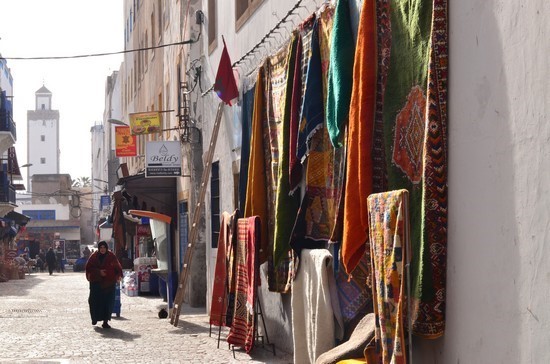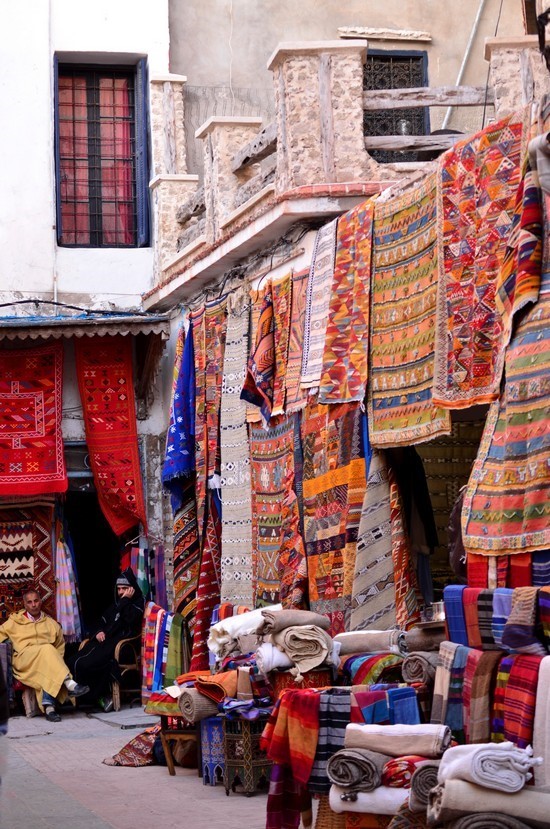The fetching Atlantic port of
Essaouira lacks the fame and grandeur of more famous Moroccan cities like Casablanca,
but that is exactly its draw. Easier to navigate than the vast medieval
labyrinth of Fez and far more manageable than hectic Marrakesh, Essaouira
(pronounced ess-uh-WEE-ruh) is coastal North Africa at its most quaint and
picturesque.
اضافة اعلان
Blue wooden fishing boats haul in the day’s
catch. Dromedaries roam the beaches. Come evening, the sunset casts its glow on
the crenelated ramparts and watchtowers. It is little wonder that productions
like Orson Welles’s 1951 “Othello” and HBO’s “Game of Thrones” have filmed
here. These days, art galleries, stylish guesthouses, and a blossoming design
scene add to the eye candy, while summer music festivals like the Essaouira
Gnaoua and World Music Festival provide the beat.
Here is the perfect agenda for a 32-hour Essaouira
stopover:
Friday4pm: Peer into the past. A portal into the
past opens down Rue de la Sqala, a passageway off Essaouira’s main square,
Place Moulay Hassan. Strolling alongside the high battlements, you pass beneath
stone arches and ascend a long ramp to reach the city’s most scenic spot: a
promenade lined with 18th-century cannons pointing out to sea.
The wide walkway and its majestic
watchtower offer sublime vistas of the craggy coast and the Purple Islands,
where ancient Phoenicians and Romans crushed murex shells to make much-prized
violet dyes. Seagulls whirl above. Waves crash below. For a moment, time stands
still.
 A street
in Essaouira, Morocco, in November 2016
6pm:
A street
in Essaouira, Morocco, in November 2016
6pm: Drink in the sunset. Maghreb, the
Arabic term for Morocco, means “sunset”, and the rooftop lounge of the
boho-chic Salut Maroc hotel, steps away from the promenade, is a lovely spot to
soak it up. Sit amid the riot of multicolored tiles and order a glass of local
Terre Blanche white wine as you gaze out at the Atlantic. On some weekend
evenings, local musicians provide a live soundtrack.
7:30pm: Feast in retro style. Dar Baba, a
candlelit restaurant with a retro-kitsch aesthetic, features banquettes made
from cheesy floral blankets, mismatched vintage chairs, and walls hung with all
imaginable kinds of curios.
The menu is awash in seafood tapas — which
encompass calamari, ceviche, and sautéed shrimp — as well as a succulent lamb
shoulder in a caramel glaze. For dessert, try a lush, Moroccanized tiramisù
larded with fig slices, rose petals, and pistachios. The wine list includes
many Moroccan wines, including Tandem, made from 100 percent Syrah.
10pm: Choose your nightcap. In the mood for
a discreet, dimly lit lounge that is perfect for sealing deals or pontificating
over cognac? Glide into Le Salon Anglais in the palatial Heure Bleue hotel. The
fireplace, wood paneling, Chesterfield couches, and cigar humidor exude
Churchillian elegance, while the fine spirits and original cocktails slake
sophisticated thirsts.
 The city wall, dating to the 18th century,
in Essaouira, Morocco, in November 2016.
The city wall, dating to the 18th century,
in Essaouira, Morocco, in November 2016.
Alternatively, channeling the spirit of
Essaouira’s most famous musical visitor, Jimi Hendrix (he passed through in
July 1969), D’Jazy evokes the city’s hippie past with bohemian décor, live
music that includes guitar duos and jazz trios, and Moroccan beer.
Saturday10am: Discover local styles. All the
accouterments of your new Moorish-modern home and wardrobe are hiding in the
lanes near the stone Sbaa gate, where a small local design scene is
flourishing. A favorite of laptop-toting global nomads, L’Atelier cafe also
sells carpets, tea services, and tableware, while the new Côté Bougie store (3
rue Youssef El Fassi) provides room deodorizers, diffusers, and scented candles
in fragrances like mint tea, spice, and orange blossom. For women’s clothing,
check out Histoire de Filles, which stocks contemporary caftans, scarves
embossed with Moorish prints, and abundant accessories.
Noon: Get lost in the galleries.
Essaouira’s most compelling galleries are as charmingly meandering as the city
itself; exploring and getting lost are half the pleasure. The most organized is
Le Real Mogador, a grandiose mansion housing rotating exhibitions of mostly
Moroccan contemporary artists, such as folkloric Mostafa El Hadar and abstract
painter Said Ouarzaz.
Larger and more eclectic, Galerie la Kasbah
is a three-level hodgepodge of sculptural horses, African masks, and paintings
that range from Saharan scenes to fever-dream hallucinations. Vaster and
stranger still, Elizir Gallery is a sprawling vintage emporium full of Egyptian
movie posters, steamer trunks, Saarinen-style chairs, spotlights, appliances,
harem pants, and paintings.
2pm: Haul in your lunch. There is a
makeshift seafood grill by the harbor, amid the briny chaos of fishmongers,
where newly netted bounty passes almost directly into your belly. This outdoor
jumble of plastic chairs and tables has no name, no address, no phone, and no
set hours — just an array of undersea delicacies that might include sardines
(an Essaouira specialty), sea bream, monkfish, shrimp, langoustine, or lobster.
To find it, pass through the colonnaded
stone El Marsa gate toward the port and veer to the right. Your selections will
be tossed on the scale, flipped onto the grill, and served with bread and diced
tomatoes. Messy and magnificent.
 Artisans
sell their wares in Essaouira, Morocco, in November 2016.
Artisans
sell their wares in Essaouira, Morocco, in November 2016.
4pm: Ride waves, or a camel. A whiff of
France’s Côte d’Azur suffuses Ocean Vagabond, a tree-shaded, indoor-outdoor
beach club (free entry) where a tanned crowd in designer sunglasses indulges in
various forms of leisure: lounging on sunbeds, shopping for beachwear, clinking
glasses of local rosé, and, most notably, marveling at the dromedaries that
roam the sands just in front of them.
To ride one, negotiate directly with its
individual handler and expect to pay 100 to 150 dirham per hour. If you want to
surf Essaouira’s modest waves, the adjacent Ion Club provides gear and lessons.
6pm: Vanish into the vapor.
The hammam treatment at Azur Art & Spa
is like a journey into some mythological wellness underworld. Nearly naked, you
are led into a hot, dark room flickering with candles, where an attendant
washes you and leaves you to absorb the heat and moisture.
In a dreamy half consciousness, you move to
a dark chamber that resembles a mausoleum and are laid out on a slab of marble
as if to be sacrificed. The ritual instrument is a rough glove that the
attendant rubs forcefully all over your body to remove dead skin. It can be
painful, but purgatory soon gives way to paradise. After an invigorating
massage, you emerge an hour later from the darkness, don a white robe, drink
restorative tea, and climb a set of white stairs into the sunlight. A roof deck
has rarely felt so heavenly. Reserve ahead.
8pm: Dine under the arches. The cooks at La
Clé de Voûte — a classy, living-room-like restaurant with stone arches and
plush banquettes — are masters of lamb, whether you take yours as a thick shank
with caramelized bananas or simply slow-cooked over coals in a clay pot along
with cumin, candied lemons, raisins, and clarified butter.
Rounding out the menu are classic Moroccan
dishes like pastilla (shredded pigeon in a crispy, savory-sweet phyllo pastry),
jazzed-up French classics (mille-feuille with goat cheese and dates), and some
flavorful vegetarian options (cauliflower drenched with Greek yogurt and zesty
red Spanish piquillo pepper sauce).
10pm: Dance on a rooftop. “Everybody Comes
to Rick’s” was the play that became the film “Casablanca”. An Essaouira version
could be called “Everybody Comes to Taros”. The restaurant-bar-club sprawls
over a multitiered rooftop built around an elevated stage for DJs and bands and
attracts a crowd that defies generalization: Moroccan youth, dreadlocked
European backpackers, English sports fans, weekending businesswomen, and
retired couples. By 11pm, the place is packed with crowds sipping Casablanca
beer and dancing to funk, techno, and more. For a quiet interlude, one flight
down is Le Club, a cozy indoor lounge serving Moroccan wines.
Sunday10am: Hone haggling skills. When you are
amassing exhibitions for your Museum of Obsolete Technologies, the teeming Sunday
flea market (called the joutia) should be your first stop. A 10-minute walk
from the Doukkala gate along Avenue Moulay Hicham, the sprawling, blockslong
market abounds in old fax machines, calculators, clock radios, VHS players,
slide projectors, turntables, and other bygone gadgetry — to say nothing of
cheap shoes, diapers, towels, chain saws, fruits, and vegetables. Amid the
chaff and sundry daily staples, you might be lucky enough to find folk art, cow
skulls, metal lanterns, hexagonal end tables, and other cool knickknacks.
Prices are open to negotiation.
Read more Travel
Jordan News







